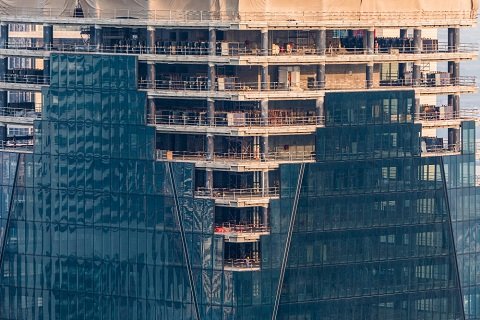Scaffolding is a fundamental component in construction, providing temporary support and access for workers to perform tasks at height. Various types of scaffolding systems have been developed to suit different project requirements, ranging from simple structures to complex configurations. In this comprehensive guide, we will explore the different types of scaffolding systems, including single, double, cantilever, suspended, and mobile scaffolding, highlighting their features, applications, and advantages in construction and other industries.
Single Scaffolding:
Single scaffolding, also known as brick layer’s scaffolding, is the most basic and commonly used type of scaffolding system. It consists of a single row of vertical standards, also known as uprights or standards, which are placed parallel to the building or structure being worked on. Horizontal ledgers are then fixed to the standards at regular intervals, creating a working platform for workers to access the work area. Single scaffolding is typically used for brickwork, masonry, and other light-duty construction tasks where the height of the structure is limited.
Double Scaffolding:
Double scaffolding, also known as mason’s scaffolding, is similar to single scaffolding but incorporates an additional row of standards outside the building or structure. This provides increased stability and support, allowing workers to access higher elevations safely. Double scaffolding is commonly used for heavy-duty construction projects, such as stone masonry, where the wall cannot support the weight of the scaffolding from the inside. By providing support from both the inside and outside, double scaffolding offers enhanced safety and stability for workers working at height.
Cantilever Scaffolding:
Cantilever scaffolding, also known as needle scaffolding, is a specialized type of scaffolding system that extends horizontally from a supported structure, such as a building or a bridge. It utilizes needles, or beams, that are anchored into the building’s floors or walls, allowing the scaffolding platform to protrude outward without the need for support from the ground. Cantilever scaffolding is commonly used for construction projects where access to the upper levels of a building or structure is restricted, such as high-rise buildings or bridges. It offers flexibility and efficiency in accessing hard-to-reach areas without obstructing ground-level activities.
Suspended Scaffolding:
Suspended scaffolding, also known as swing stage scaffolding, is a versatile type of scaffolding system that is suspended from the top of a building or structure using ropes or cables. It consists of a platform that can be raised or lowered to the desired height, allowing workers to access different levels of the building facade or structure. Suspended scaffolding is commonly used for exterior building maintenance, painting, window cleaning, and other tasks that require access to elevated areas. It offers flexibility and maneuverability, enabling workers to move horizontally along the facade while maintaining a stable working platform.
Mobile Scaffolding:
Mobile scaffolding, also known as rolling scaffolding or tower scaffolding, is a portable and modular type of scaffolding system that can be easily assembled, disassembled, and moved around the job site. It consists of a base unit with wheels or casters, vertical frames, horizontal braces, and a platform deck. Mobile scaffolding is commonly used for maintenance, repair, and construction tasks that require frequent repositioning, such as painting, plastering, and electrical work. Its lightweight and compact design make it ideal for indoor and outdoor applications, offering convenience and versatility for workers on the job site.
Other Types of Scaffolding Systems:
In addition to the aforementioned types of scaffolding systems, there are several other specialized scaffolding systems designed for specific applications and project requirements. These include:
- Modular scaffolding: Consists of pre-fabricated components that can be assembled into various configurations to suit different project needs. It offers flexibility, efficiency, and ease of assembly, making it ideal for large-scale construction projects.
- Trestle scaffolding: Consists of a series of movable platforms supported by tripods or A-frame structures. It is commonly used for interior finishing work, painting, and ceiling repairs in residential and commercial buildings.
- System scaffolding: Utilizes standardized components, such as frames, braces, and connectors, to create a modular scaffolding system that can be easily assembled and adapted to different project requirements. It offers versatility, stability, and efficiency for a wide range of construction tasks.
- Tube and coupler scaffolding: Consists of steel tubes and couplers that are interconnected to create a stable and durable scaffolding structure. It is commonly used for heavy-duty construction projects, such as industrial buildings, bridges, and infrastructure projects.
Applications and Advantages of Different Scaffolding Systems:
Each type of scaffolding system has its unique features, applications, and advantages, making it suitable for specific construction tasks and project requirements. By understanding the characteristics and capabilities of different scaffolding systems, contractors and workers can select the most appropriate system for their projects, ensuring safety, efficiency, and productivity on the job site.
Single scaffolding is ideal for light-duty construction tasks, such as brickwork and masonry, where the height of the structure is limited. It is simple to erect and cost-effective, making it suitable for small-scale projects and temporary applications.
Double scaffolding provides increased stability and support for heavy-duty construction projects, such as stone masonry, where the wall cannot support the weight of the scaffolding from the inside. It offers enhanced safety and stability for workers working at height, minimizing the risk of accidents and injuries on the job site.
Cantilever scaffolding is ideal for construction projects where access to the upper levels of a building or structure is restricted, such as high-rise buildings or bridges. It offers flexibility and efficiency in accessing hard-to-reach areas without obstructing ground-level activities, enabling workers to work safely and efficiently at height.
Suspended scaffolding is versatile and maneuverable, making it suitable for exterior building maintenance, painting, window cleaning, and other tasks that require access to elevated areas. It offers flexibility and stability, allowing workers to move horizontally along the facade while maintaining a stable working platform.
Mobile scaffolding is portable and easy to assemble, disassemble, and move around the job site, making it ideal for maintenance, repair, and construction tasks that require frequent repositioning. It offers convenience and versatility for workers on the job site, enabling them to work safely and efficiently in various locations.
Conclusion:
Scaffolding is an essential component in construction, providing temporary support and access for workers to perform tasks at height. Various types of scaffolding systems have been developed to suit different project requirements, ranging from simple structures to complex configurations. By understanding the characteristics and applications of different scaffolding systems, contractors and workers can select the most appropriate system for their projects, ensuring safety, efficiency, and productivity on the job site.
References:
- “Scaffolding (construction)” – Wikipedia, https://en.wikipedia.org/wiki/Scaffolding_(construction)






